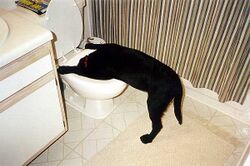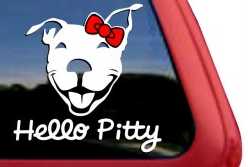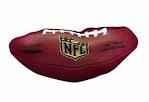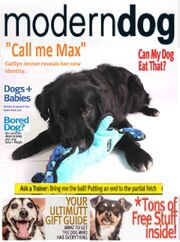Dog
Dogs (Canis lupus familiaris or Canis familiaris) are domesticated canids that have been selectively bred for millennia to play ‘ball’, ‘find it’, round up groups of stupid wooley white animals and bury bones. Their physical anatomy is specifically designed for sniffing hedges, chasing small round yellow bouncy things or car wing mirrors, tail wagging, and barking, with recovery periods required to be taken lying upside-down on sofas, or hairy rugs by a nice warm fire. Very common names for dogs include Max and Spot.
Dogs are the most diverse species on earth, ranging from small argumentative ratters to giant hounds that prefer to take a quieter, more philosophical approach to dealing with other dogs or animals. Dogs have a wide variety of jobs, including frisbee-catchers, woodland explorers, stick rescuers and street patrollers. Some dogs are employed to sit on laps, whereas others work in the fashion industry as handbag accessories.
There are many dog celebrities, such as Lassie, Brian, Snoopy and Spot. Laika was the world's first astronaut[1] and Spuds the bull terrier is the face of Budweiser.
Monsters
Most dogs live in symbiosis with one or more monsters. The reason for this is that there is food anywhere — a fact that no dog will quibble about — and the food is in pretty good condition if the dog can get to it before the monster does. Some dogs must wait an interminably long time while the monster teases and plays with its food, and try to snatch it off the cutting board before the monster spoils it completely.
Monsters could be lethal to a dog; a dog is unlikely to be able to do more than detach an ear in a confrontation with a monster before the monster got the upper hand. However, most monsters seem reasonably well tamed, though young monster spawn is not.
The monster will always try to humiliate the dog, such as by attaching meaningless metal to its neck and making it learn useless "tricks," but the dog shows its superiority by tolerating these affronts without drama. In the end, the dog gets the food.
One such trick has a positive effect. The owner will go out on patrol attached to his monster by a strong cord. Despite the lunacy of having two patrollers cover virtually the same territory, it prevents the dog from not being able to return home, if he should out-drive the available urine, and having to look for a new monster to own.
Traits of monsters
Monsters are inscrutable. They seem to have noses, such as they are, and the noses seem to function, as monsters become worked-up whenever a dog tries to give a living space a more natural smell, but they mostly live in a world heedless to its smells. Any dog who accompanies its monster into groups of monsters has seen them exchanging pieces of paper with nothing written on them at all. They also have something where the claws should be, but with all the fussing they do with them, they will never grow back to usefulness.
The strongest trait of a monster is its secretiveness. Monsters go to great lengths to ensure that a dog cannot tell what the monster ate, how recently, or whether the monster got into a confrontation. The monster masks all of his recent history in a set of obnoxious smells. So, although the monster goes through the motions of playing with the dog, the truth is that the monster does not want the dog to know anything at all. Fortunately, the dog has guile and cunning and the monster does not.
The worst trait of a monster is that he will never put his excrement to good use such as marking territory or trails — something the monster does not seem to do at all — but puts it in a water bowl, and then makes it disappear entirely. Monsters are fortunate that dogs are willing to live with them, to take over these vital tasks.
When a dog gets close to a monster, the monster will emit meaningless sounds, while looking the dog in the eye and even baring its teeth. No one knows what the former is about, while everyone knows what the latter is about, though if the dog takes up the obvious invitation to fight to the death, either outcome puts access to food at risk.
Menageries
A monster who accepts a dog in often opens his lair to additional interspecies visitors. Unfortunately, this often includes cats. Cats are fur utterly unjustified by body mass, and always become the prima donna of the household. A cat sucks up to the house's monster by obsessing about cleanliness and by being uncommunicative, burying its wastes probably just to irritate the dog. The only thing they do that is somewhat useful is climb trees, and a dog can amuse itself by chasing the family cat just to see it do so.
Diet
The Dog Community is fortunate to live in a part of the universe where virtually everything is edible or at least chewable. If the dog should get lost, a moment of sadness for its former companions flits away in the face of a new challenge to determine what local things or entities are the tastiest. The core principle of the dog diet, cheaply paraphrased by George S. Patton to adapt it to war, is the mandate to "Eat everything — and let God sort it out." The dog's mercifully short digestive system ensures that any discomfort will be trivial compared to the comfort of a good meal.
Likewise, overeating is not a problem, as the dog eats all that is available and depends on its body to signal in one of the various ways that that was too much or was the wrong stuff, at which time the dog can resume overeating.
Dogs do pass gas,[2] and it is a notable mark of the dog's superiority that those who cohabit with monsters (see above) are magnanimous when their monster treats this good-faith effort to communicate as some sort of a character defect, even though the hypocritical monster has a full day of excess intestine and produces most of the flatulence in the household.
Interaction
I'm a fine, handsome and clever boy. How do I know? I know because my monster 'mummy' tells me so. All. The. Time. I am made to 'come over here for a bit of mummy's love'. Annoying — I was having a good bollock-scratching session — but I do it. I do it because monsters are nuts, absolutely bonkers and I have her exactly where I want her. Seriously, if I don't fancy eating the stuff she puts down for me, I walk away with my head down and put on my sad face. No joke, if I do this twice in one day, boom, she will actually go to the shop and serve me up pure, real, 10% Irish beef mince.
Dogs are very socially advanced, able to interact with monsters and other things. As a rule of the paw, the bigger and/or more dribbly the dog, the more inclined it is to be social. The most courteous way to find out whether a dog is feeling social is to get under its tail and sniff its butt. Unfortunately, even after regular demonstrations while on patrol, monsters still refuse to use this simple form of interaction. Instead, they wave a biscuit about, which is a bit demeaning.
Monsters emit a wide range of sounds, as though specific sounds had particular significance, a hard concept for a dog to grasp, but unimportant in any case. However, dogs can sense that certain monster sounds correlate with good or bad things happening and behave appropriately. Monsters may even act as though specific sounds identify individual dogs, another bit of monster self-satisfaction of no utility to the dogs, as anything good or bad that is going to happen to one individual is of pressing interest to the others too.
Monsters act as though dogs are cute, and it is no wonder, as monsters have silly ears, a dry nose, and no tail, and they stand on their hind legs a lot. They also smell terrible, nothing like other creatures, more like plants and flowers mixed with stag urine; and they regularly remove what little fur they have. Being cute has huge advantages for manipulating monsters, especially if you have had a little accident in the guest room, or finished off the roast beef before it got cooked. A waggy tail, puppy eyes, putting paws over your nose and whining, not only get you forgiven but will probably get you a biscuit.
Culture

Canine culture covers just about every medium, from TV and film to art and high-maintenance fashion hounds, sniffing out the latest vogue in tartan coats, collars, and leads. Dogs are huge fans of high-brow outdoor pursuits, such as pheasant shooting and rabbiting. Fox hounds used to live for the annual hunt, before it was stopped by the humans in favour of a straw-dog policy of chasing something smelly instead — which is a pity, because a fresh fox, picked straight from the woods, is far tastier than an old towel marinated in Pedigree Chum. Unless, of course, you are a black Labrador; a breed that does not discriminate between meat and household items when it comes to nourishment.
Dogs are sporty and competitive, they have televised national and international leagues of agility, stick catching, ball retrieving and herding. Globally, air forces adopt dog-fighting techniques in combat, attack-dog politics are alive and well in parliaments and no other species has proved as good at archaeology when it comes to finding ancient bones.
Film and TV
Dogs made their break into silent movies during the silver screen days with Rin Tin Tin, a German Shepherd that saw action on a WWI battlefield; the artist-Alsatian had the honor of being the first ever to be voted for an academy award for best actor. However, Rin Tin Tin’s nomination became a bone-of-contention, after he tried to show his appreciation by mounting the leg of one of the judges. It was then decided that a human should get the first one, marking the first of many accusations of discrimination.
The first bone-fide ‘A-lister’ was Terry the Terrier who was cast as Toto in the Wizard of Oz, supported by human actor Judy Garland. In the 1980s, Hooch just had one of those faces that the camera loved, and was instrumental in taking Tom Hanks from a pup-actor to running with the big dogs of mainstream film and TV, with his patient sitting, staying and dribbling. Canine capers have been all the rage for decades, with Lassie, Timmy and Benji forever rescuing dosy kids from wells. K9 was a time-traveling companion to Dr. Who and Beethoven just took the piss out of his owners.
Media
There are many dog magazines: Modern Dog, Your Dog, Dogs Today, Dog Monthly, and Bark, to name a few. Regular columns in newspapers feature dogs, such as Snoopy and Odie. Dogs also regularly make for a scoop or two with avalanche rescues, looking after those with medical conditions, and winning medals for bravery in combat.
Social media, unfortunately, favors cats. This is hardly surprising since neither cats nor social media users get out very often. Dog websites focus on coexisting with monsters. They offer tips on which shoes provide the best chewing experience, why it is okay to bury a bone in the sofa, and how to achieve plausible deniability regarding a missing sponge cake, even when frosting all over the chops suggests otherwise.
Amazon sells ‘dog music’ CDs for canine relaxation and therapy. In advertising, the hound is the leader of the pack. From Taco Bell to toilet roll, cars to car insurance, dogs are some of the most successful marketers in the business, despite having no idea about the product, whether it tastes nice or whether it will taste better after being beneath the lawn for a week or two.
Fashion
Certain dog breeds are not only fashionable but fashion-obsessed. Many dogs express themselves through fashion. As ‘Simmel the Spaniel’ once barked: “style is the manifestation of our inner wolf and through style we demonstrate our taste, values, and status in a dog-eat-dog society. We project all of those qualities onto our owner when we dress them, and they dress us.”
Dog fashion is reflected in how canines dress their monster companions as well. It is as widely remarked in the dog world as in the human world that interspecies companions slowly come to resemble one another.
Dog clothes are available in various price ranges from inexpensive collars for the family mutt, to high-end designer styles for toy and small breeds such as Chihuahuas and Yorkshire Terriers. Even large breeds like Golden Retrievers can wear clothes too but prefer a grungy, dog-eared look. Fashion-show emphasis is very much on the clothes, not on the minxes, even though they are cute. In countries all over the world, the busy trend-Setters have become so important that in 2011, New York hosted the first Dog Fashion Week, called Last Bark at Bryant Park, featuring knitwear for Siberian Huskies, under the section ‘Your wolf in sheep’s clothing'.
However, fashions change over time. Dalmatians were the ‘it breeds’ among the young and trendy in the sixties, creating an entire wardrobe of spotty skirts and tops for the owner. 'Duvet Diva' lapdogs are all the rage among elderly romantic novelists and young females getting into the beauty trade. The 2016 Robertson Tartan Collection overcoat is a must-have for disobedient Highland Terriers constantly begging for referendums biscuits.
Sports
Sports are the next best thing to food, and are essential for a dog's well-being, and the well-being of anything chewable in the house. Sports are enjoyed at every level, from ball retrieval in a meadow to fully timed assault courses, often televised, with crowds in the thousands. Dogs far surpass other species when it comes to jumping, rolling-over and fetching tennis balls.
Dogs can also swim. Dogs were the sole inspiration for an important swimming stroke. The dog paddle is popular among school children and would be more popular if it did not lead to a diagnosis of autism so often.
Barking while competing is controversial, and the worst offenders are border collies. Like lady tennis players, barking on court is considered amusing to the spectator, but rude and off-putting to other competitors. It happens because the handler from Chelmsford is mentally at least five obstacles behind the collie — a working dog bred to respond to over six whistled instructions per second when herding sheep, cover 25 miles a day jumping fences and ditches and driving a tractor.
Your average canine, however, is satisfied with twice-daily tennis ball related activities while on patrol. Sometimes monsters forget their patrolling duties, so it is the dog's job to remind them with fake yawning, whining and stretching. Failing that, dropping a tennis ball in front of the monster and barking, or taking a piss in the kitchen gets the message across.
The vet
This is the real problem with living with monsters. They can put you in a state where you don't care that they're prodding you with tools. One time I went there, they took off my balls! At least, I seem to think I had balls down there. Fortunately, I feel just the same. Anytime I wind up in there, I find a way out.
Dogs that cohabit with a monster are shocked to find that any minor mishap such as an encounter with a porcupine leads to confinement and a trip to a committee of many other monsters. They have a soft touch but the monster's signature preoccupation for examining in unnatural detail a small gash or a broken bone that, in time, would have healed naturally. The ritual is again accompanied by that recurring monster ritual of exchanging a lot of paper that seems to be blank.
On a more major mishap, dogs will seek a ditch or a culvert, mostly to avoid giving the monster another chance to trot out the "trip-to-the-veterinarian" ritual.
Reality
The testimonial in the above sidebar sums up the world-view of dogs. The past has always been essentially the same as the present, barring inconsequential differences, and there have been problems, always resolved by the dog having guile that any monsters in the vicinity do not. The challenge of a new day is not to make sense of anything, but to get out and find out how everything smells today, who has been about, and what he has eaten and how recently.
Dog language borrows from other backyard animals, in the sense that the verb for "eat" has the same root as the verb for "steal." However, any anger, recrimination, or guilt lasts no more than fifteen seconds and is always assuaged by a stroke of the tummy. Dog morals are best summarized, as Brian McNamee testified to the U.S. Congress, that "it is what it is," as when there is a need to explain why the entire Easter cache of chocolate is now a vomited pile on the living room carpet. Going forward, the operative strategy, as Lech Walesa explained on the election of Barack Obama, is: "Let's just do our stuff.”
Notes
- ↑ Laika also became the first celebrity casualty of the space program, far pre-dating the American schoolmarm-in-space. The Russians made no return plans for Laika, but engaged in Kamikaze science.
- ↑ Cows famously produce more. Then again, cows also produce more milk.
See also
| Featured version: 16 April 2017 | |
| This article has been featured on the main page. — You can vote for or nominate your favourite articles at Uncyclopedia:VFH. | |








